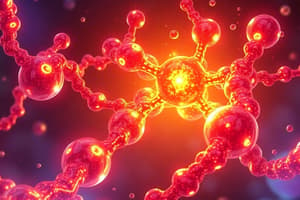Podcast
Questions and Answers
Which functional groups are present in amino acids?
Which functional groups are present in amino acids?
- Alcohol and aldehyde
- Ketone and amine
- Amino and carboxylic acid (correct)
- Ester and ether
How many amino acids are incorporated into proteins according to the text?
How many amino acids are incorporated into proteins according to the text?
- 100
- 10
- 22 (correct)
- 50
Apart from their role as residues in proteins, what other processes do amino acids participate in?
Apart from their role as residues in proteins, what other processes do amino acids participate in?
- Photosynthesis and respiration
- Blood clotting and immune response
- Neurotransmitter transport and biosynthesis (correct)
- Cell division and apoptosis
What is the largest component of human muscles and other tissues, aside from water?
What is the largest component of human muscles and other tissues, aside from water?
How are amino acids formally named according to the IUPAC-IUBMB Joint Commission on Biochemical Nomenclature?
How are amino acids formally named according to the IUPAC-IUBMB Joint Commission on Biochemical Nomenclature?
Flashcards
What functional groups are present in amino acids?
What functional groups are present in amino acids?
Amino acids are organic molecules containing both an amino group (-NH2) and a carboxyl group (-COOH).
How many amino acids are incorporated into proteins?
How many amino acids are incorporated into proteins?
Twenty-two amino acids are incorporated into proteins during translation, forming the primary structure of proteins.
What other processes do amino acids participate in?
What other processes do amino acids participate in?
Apart from their role in protein synthesis, amino acids participate in diverse biological processes, including neurotransmitter transport and biosynthesis.
What is the largest component of human muscles and other tissues besides water?
What is the largest component of human muscles and other tissues besides water?
Signup and view all the flashcards
How are amino acids formally named?
How are amino acids formally named?
Signup and view all the flashcards
Study Notes
Amino Acid Functional Groups
- Amino acids contain both a carboxyl (-COOH) and an amino (-NH2) group.
Amino Acids in Proteins
- 20 standard amino acids are incorporated into proteins.
Roles of Amino Acids
- Apart from being residues in proteins, amino acids participate in neurotransmission, biosynthesis, and intermediary metabolism.
Tissue Composition
- Proteins are the largest component of human muscles and other tissues, aside from water.
IUPAC-IUBMB Nomenclature
- Amino acids are formally named according to the rules of the IUPAC-IUBMB Joint Commission on Biochemical Nomenclature.
Studying That Suits You
Use AI to generate personalized quizzes and flashcards to suit your learning preferences.



